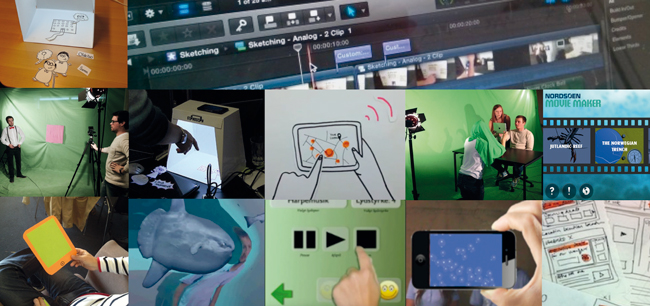PhD Thesis by Peter Vistisen: Animation-Based Sketching - An Explorative Study of How Animation-Based Sketching Can Support the Concept Design of Non-Idiomatic Digital Technologies
In this thesis, I expand upon using animating as a sketching approach to communicate, and explore interaction and user experience design concepts of technologies, that are hard to grasp via traditional means of sketching. I propose that the sequential, temporal, material, and narrative qualities of animation may sufficiently be considered an extended category of sketching. The subject matter is exploring of the viability and feasibility of new user experiences with so-called non-idiomatic technologies - that is, technologies with few or no established conventions or idioms. In the thesis, it is my hypothesis, that animation can be used as a sketching approach to explore such design situations, before spending resources on building functional versions. As such the research is guided by the following research question:
How can animation-based sketching support the concept design of non-idiomatic digital technologies?
Through a series of explorative studies, conducted as both a constructive designer, as well as facilitator of other designers, I have experimented with different applications of animation-based sketching. These experiments all build on a pragmatic view on constructive design research, and have been conducted in collaboration with outside practices, among them the ‘North Sea Oceanarium’ aqua zoo, and the design agency ‘Tankegang’. A series of workshop experiments, with design students collaborating with more than 30 companies also form a major part of the experimental data in the thesis.
Furthermore, I have sought to clarify the concept of extended sketching capacities to include animation. From a state of art analysis of theory, I define animation-based sketching as the use of animation to portray a fictional reality, aimed at it becoming a fact of reality. I have positioned this in regard to static sketching, and functional prototypes, framing animation as a way of emulating the dynamic behaviour of proposed interactive technologies.
In the thesis, I have shown how designers, who deal with non-idiomatic digital technologies, can utilise animation-based sketching as a temporal sketching approach. I have proposed animation-based sketching as an extension to previous efforts into using video in sketching, with specifically defining and addressing the qualities animation adds to the representation of interaction and user experience design. I have used the technique ‘annotated portfolios’ to collect a broad range of animation-based sketches. From purely animated sketches, to live video being augmented with animated overlays. Done in both high and low visual and temporal fidelity, I argue these portfolios of sketches augment the theoretical claims of the viability, and feasibility of using animation to represent and explore the potential of a proposed idea.
I have shown, how animation-based sketching can be done through different visual and temporal fidelities, enabled by a variety of techniques, materials, and in different software and hardware production environments. These appliances show, how the temporal dynamics of non-idiomatic technologies can be explored from the very earliest idea, to later issues about interaction, context implementation, and potential technical contraints, and pitfalls for the user experience.
My studies contributes with examples of the scope of this specific temporal design approach - from supporting design students exploring their design ideas, to being the driving force in facilitating consensus in multidisciplinary design processes in the industry. These contributions are sought condensed into theoretical frameworks and practice-oriented guidelines, which are grounded in my experiments, and aimed towards qualifying animation as a sketching capacity for designers in practice.

